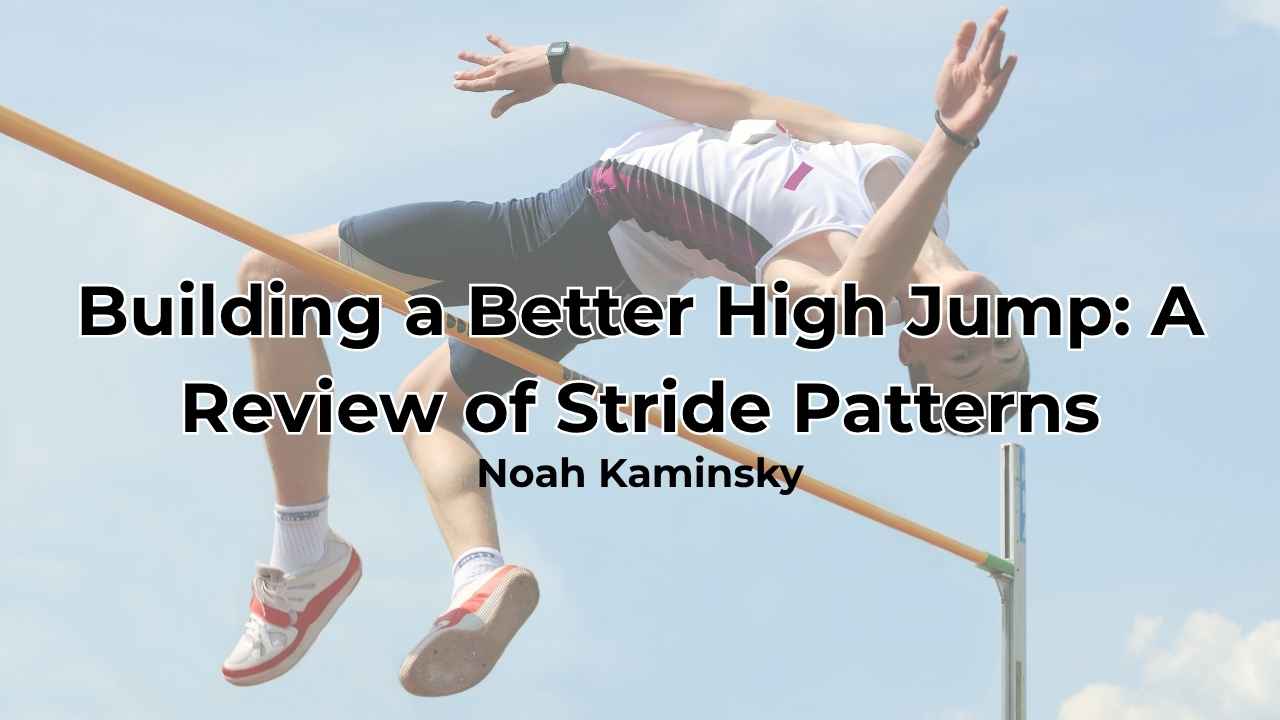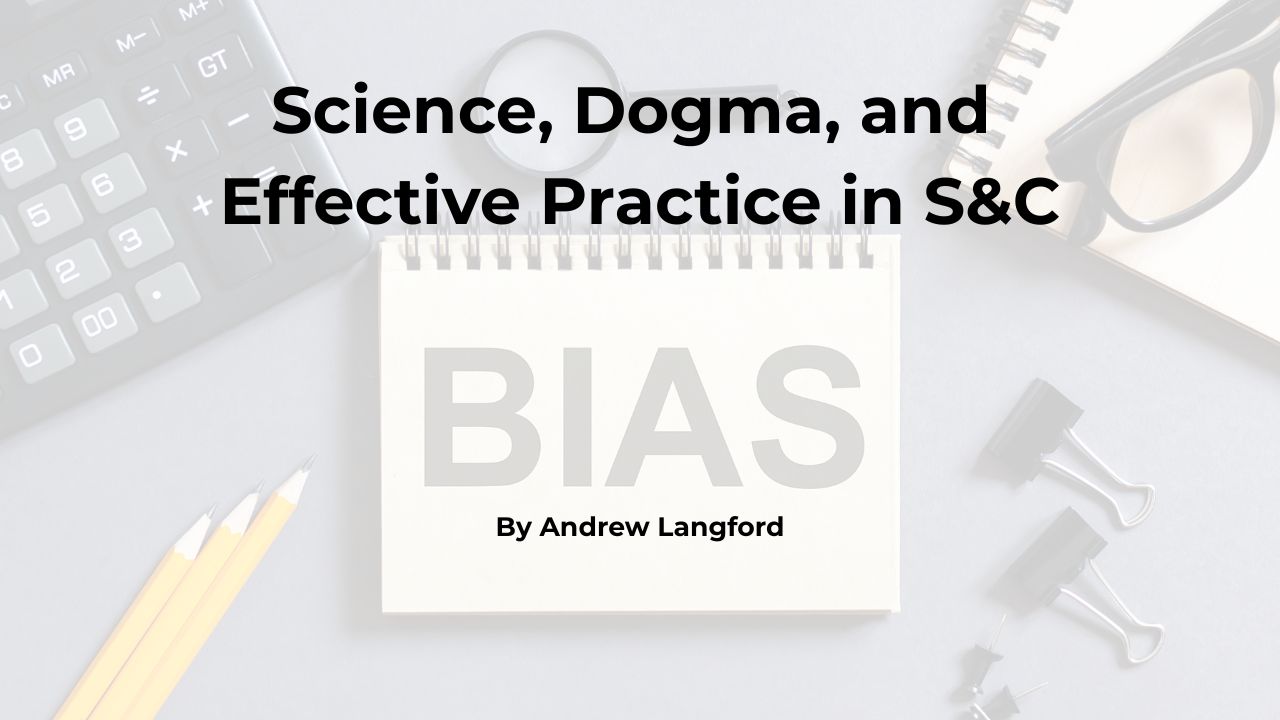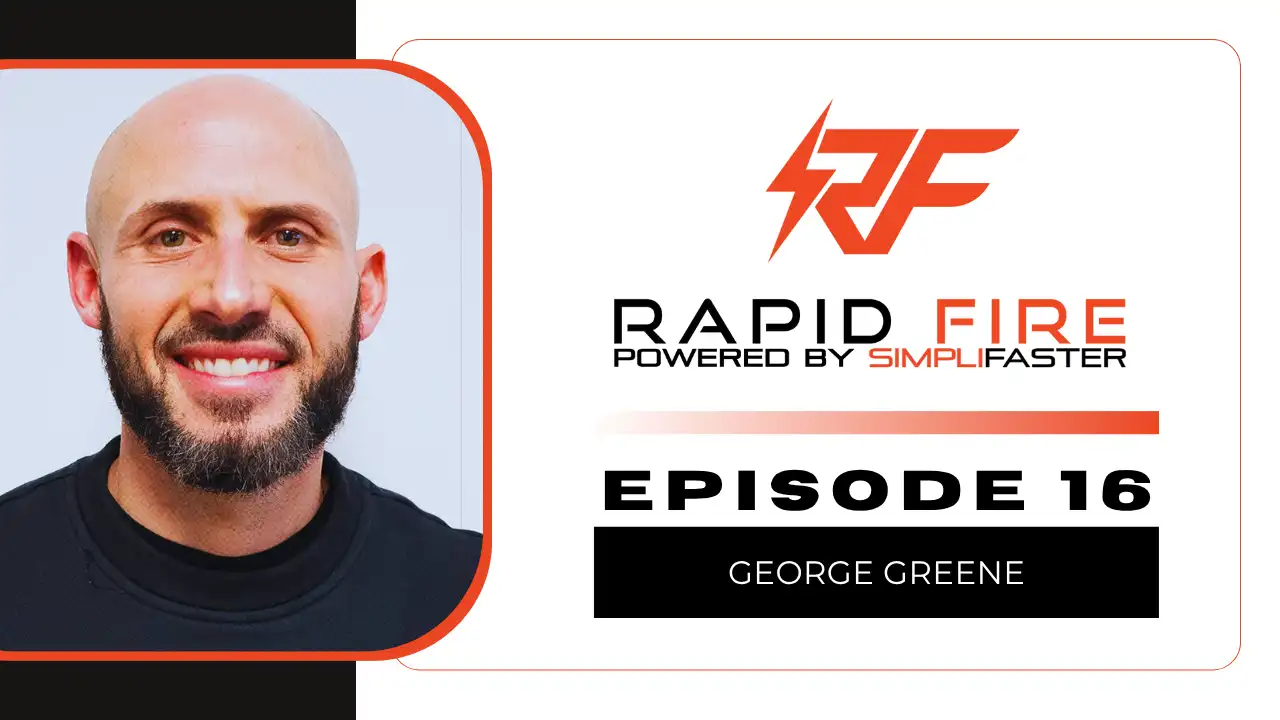[mashshare]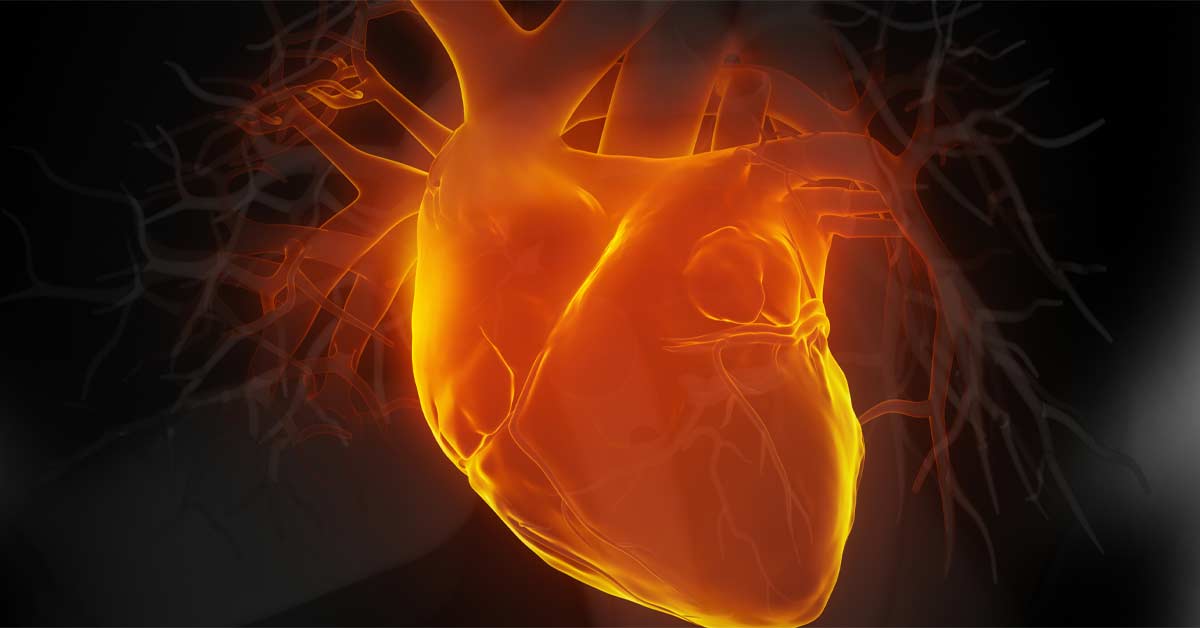
“VO2 max can be improved, on average, by only 5-15%, even with intensive training. It is clear, then, that the average person can train as much as he or she likes yet never achieve a VO2 max anywhere near that of elite athletes.” – Tim Noakes (Lore of Running)
Since my first exercise physiology undergrad classes, some 25 years ago, I have been taught the above “truth.” That is, that one of the most important physiological attributes for endurance athletes—VO2 max—is largely fixed, largely genetic, and if you don’t like your own number, “blame your parents.”
But just how true is this widely held belief?
Putting aside the sedentary twin studies and the short-term papers, if we turn to the real world and look at the observations of an exercise physiologist whose primary job was testing athletes—often the same athletes over multi-year time frames—how does the belief that VO2 max is largely untrainable stack up? If we watch real athletes over extended periods of time, what kind of gains are we likely to see? That is the perspective and those are the answers I hope to provide in this post.
Understanding VO2 Max in Team Sports
First, a quick recap on what VO2 max is and why it’s important. VO2 max, or the maximal oxygen uptake, is the total amount of oxygen that your muscles can extract from your blood per minute. It represents the overall strength of the aerobic system and is the product of oxygen delivery (from the heart and lungs) and oxygen uptake (from the muscles).
VO2 max is an important metric for endurance athletes because when energy is generated aerobically (in the presence of oxygen), the by-product of glycolysis (sugar burning) can actually be used to create even more energy (via the Krebs cycle) rather than “hanging around” in the muscle and contributing to acidosis and subsequent fatigue. While energy generation might be a little slower than anaerobic processes, it can take an athlete a whole lot further for a given amount of fuel. Hence, its importance to endurance events.
While VO2 max is an important metric for endurance athletes, it also plays an important role in the between-effort recovery in most team sports, says @alan_couzens. Share on XHowever, even in “intermittent events” like most team sports, it plays an important role in the between-effort recovery. Even if the critical moments in a given event are anaerobically dominant, a strong aerobic system and all that comes with it (development of the “lactate gobbling” type 1 fibers, increased capillarization within the muscle to allow faster transport of the “good stuff” in and the “bad stuff” out) gives the athlete the ability to recover quickly between these crucial efforts, facilitating more of them within the game. The same principle is even more true in training, where the ability to recover quickly between specific training bouts ultimately allows more quality training within the program.
With the above in mind, it should come as no surprise then that the best endurance athletes in the world have very high VO2 max values. Even athletes from sports not typically considered “endurance” sports still exhibit relatively high numbers, as shown in the table below.
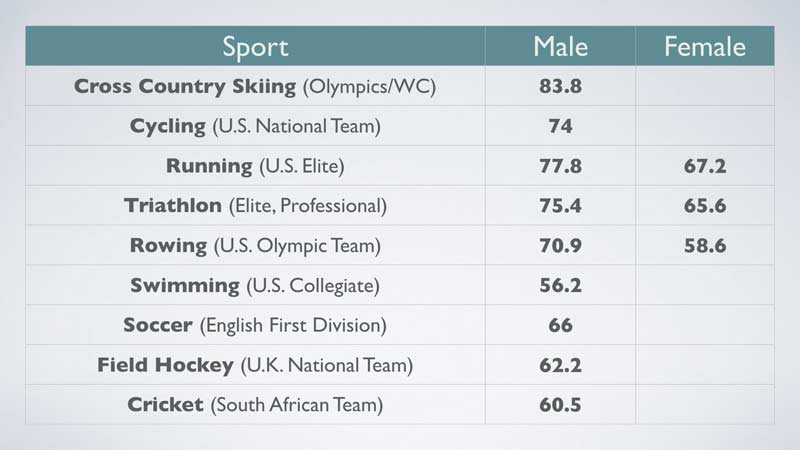
Now, back to our depressing revelation: There’s only 5-15% potential improvement. Not a whole lot of wiggle room there. If you come into the lab and I test you as having a VO2 max of 50 ml/kg/min, the best you can hope for with “all the training in the world” is an improvement to ~57 ml/kg/min. With world-class males typically scoring 75-85 ml/kg/min and world-class females scoring 65-75 ml/kg/min, an improvement from 50 to 57 isn’t going to put you in sight of winning most local races, let alone validate your dream of winning a big one!
And, indeed, there was some science to back up this “rule of thumb.” A study that looked at VO2 max values in twins1concluded that genetic factors explained 72-74% of the difference in VO2 max and, even when “sports participation” was factored in, genetic factors continued to explain between 57% and 63% of the variance in VO2 max. Presumably, studies like this formed the basis of the belief that VO2 max was largely genetic and could only be increased by a small amount through training.
My first VO2 max test during my exercise physiology undergrad yielded a VO2 max of 62 ml/kg/min. Not bad, but not great either, especially for someone who had spent the better part of the previous decade following the black line up and down the pool. It seemed to line up well with my experience of never quite having that quality to make it to that next level. That 62 ml/kg/min “well trained” would put my life range from untrained to trained in the 53-62 ml/kg/min ballpark, dooming me to a life of middle-of-the-pack athletics. And the story gets even more depressing…
Many years after my first VO2 max test, we set up an exercise physiology lab here in Boulder, Colorado, and I got my hands on a fresh, new metabolic cart. So, of course, I had to put it through its paces. This time around I tested at 49 ml/kg/min! I was hardly what I would call untrained at the time—still competing recreationally in triathlon. Nor was I old enough that age should have a large impact, and yet my VO2 max had already shifted downwards by ~20%! Rather than drowning my sorrows, such a shift had me asking: If my VO2 max can change so significantly, beyond what I had learned was the “norm” in my studies, could it change the other way?
Fortunately, I wasn’t just an exercise physiologist. A big part of my “second job” as an endurance coach was to try and have a positive impact on the VO2 max of the athletes I worked with. This meant that, over long periods of time—years, in many cases—I was performing repeated testing on the same athlete, while carefully monitoring and quantifying the training load, and seeing how this VO2 max value shifted in response to the training. And (spoiler alert) the shifts that I witnessed were far greater than the 5-15% that I had been taught to expect!
One particular case study of an athlete that went WAY beyond that 5-15% improvement in VO2 max comes to mind…
The Case Study: Why Real-World Testing Matters
I started working with a youngish, middle-of-the-pack athlete with some big goals. He had come from a history of rotating through a number of intensity-based programs and was frustrated at the plateau despite “working as hard as I could.” In more detail, the programs typically involved focused periods of 3-4 months before the key event, which would begin with high-intensity (threshold and “VO2”) trainer intervals and progressively extend to a few specific long rides/runs before the event. After the event, he would take a couple of months off/unstructured to mentally recover from the high-intensity training and then begin the cycle again. As a part of the initial assessment, we got the athlete into the lab for a full workup including a VO2 max test. The result? A fairly modest 53 ml/kg/min.
Again, knowing what we “know,” we might say to him (or at least be thinking), here is a guy who, as someone preparing for repeated Ironman triathlon events, is clearly not untrained. So, with a trained VO2 max of 53 ml/kg/min, his long-term goal of qualifying for the Ironman World Championship might be overly ambitious, at best. For comparative purposes, most male athletes in that age group who I have coached and who have achieved that level are closer to 65-70 ml/kg/min. Even at the low end, this would represent an improvement of 22% in VO2 max (from an already trained state)! Perhaps it was my duty to send this guy on his way? Or at the very least, let him know “not gonna happen, champ.” Well, fortunately, we didn’t take that route…
Over the course of the next three years, this athlete shifted his VO2 max from 53 to 74 ml/kg/min: An increase of 40% from a very middle-of-the-pack number to an elite level! And, in the process, he achieved his goal of qualifying for the Ironman World Championship.
Figure 2 shows the progression in VO2 max values for this athlete over each year of training…
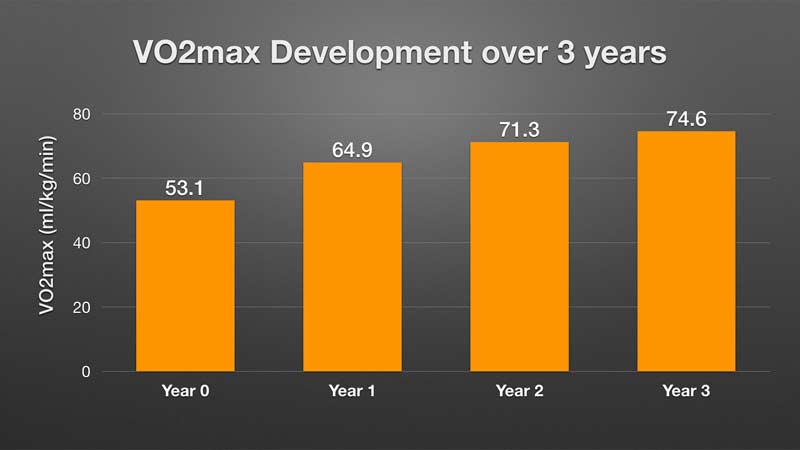
So, how did we accomplish such a large change (above and beyond that suggested by the literature)?
While the majority of the short-term literature that has looked at interventions to increase VO2 max has focused on the impact of high-intensity training (so-called “VO2 max intervals”), we took a different approach. In this case, the bulk of the athlete’s training was in and around the aerobic threshold (the first lactate turnpoint—i.e., at lactate levels of 1-2 mmol/L). A LONG way from VO2 max.
My basis for using low-intensity, high-volume training as a potent stimulus for large changes in VO2 max is the observed relationship between training volume and cardiac stroke volume. Share on XMy rationale for using low-intensity, high-volume training as a potent stimulus for large changes in VO2 max comes from the observed relationship between training volume and cardiac stroke volume, one of the most important and modifiable factors in VO2 max. In a large EKG study of athletes’ heart morphology, Berbalk discovered a strong, almost linear, relationship between training volume and total heart volume,2as shown in figure 3.
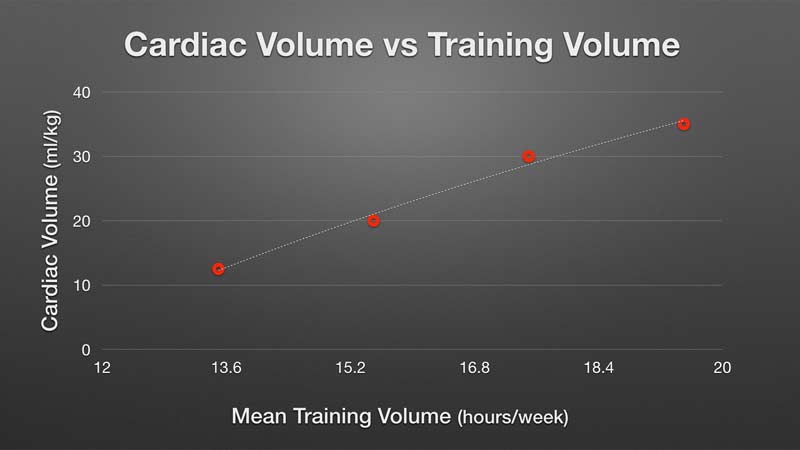
That is, the total volume of the athletes’ hearts, scaled not with the intensity of training, but with the average weekly volume! This makes good physiological sense, since we know that for the majority of people, stroke volume reaches its maximum limit at relatively low intensities of training (~40-60% VO2 max).3However, as the Berbalk data suggests, it takes a whole lot of beats to make these significant changes!
Additionally, there are positive peripheral adaptations that are favored by LSD (“long, slow, distance”) work. Harms and Hickson concluded that changes in mitochondrial content within the aerobic fibers largely scaled with the number of contractions rather than the intensity of effort.4Since mitochondria represent the oxygen processing “factories” within the muscle, more available mitochondria means more potential oxygen extraction from each beat.
This emphasis on low-intensity aerobic training represented a marked departure from what the athlete had done prior to working with me. One of the most interesting aspects of the current wave of technology and data collection for me, as a coach, is that I learn a lot about what other coaches are doing purely from the logs that the athlete brings with them. In this case, he had been doing a lot of threshold and VO2 max training. You can see the clear difference in relative proportions of the annual training intensity distribution in figure 4 from his year prior to working with me (year 0) to his highest fitness in year 3.
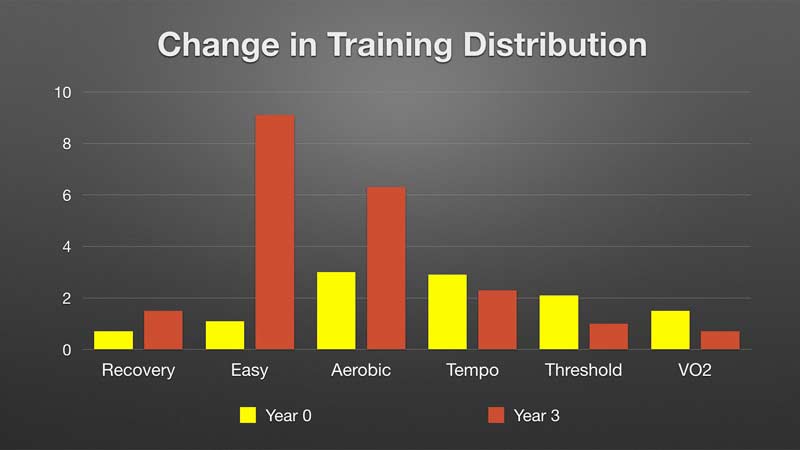
Prior to working with me, the athlete did very little work below 80% max heart rate. Most of the work he did in this range was restricted to just warming up for the “main event.” We made a large shift in this training emphasis by adding a lot more easy aerobic work (~65-80% max heart rate) and a lot less high-intensity work (~85-100% max heart rate). Paradoxically, less “VO2 work” resulted in a significant boost to the athlete’s VO2 max!
While the athlete didn’t have VO2 data from before beginning his high-intensity program, his recollection was that his power numbers on the bike improved quickly but then plateaued and then stayed “stuck” at that point following each build. This pattern of stagnation with athletes who focus on high-intensity (traditional “VO2 max”) training is a common one.
This is not to say that traditional VO2 max intervals (3-5 mins @ 95-100% max heart rate ~1:1 recovery) are useless; merely that they are the proverbial icing on the top rather than the cake itself. Athletes can certainly reach a point with pure aerobic training where they are so efficient that they are no longer able to max out their aerobic power. This is indicated by an inability to reach a VO2 “plateau” during a test where, despite increased work, VO2 stabilizes. When an athlete fails to get to this plateau, a small dose of VO2 max intervals can be very effective in eking out those last few ml/kg/min. However, in this case, this form of training represents the move from 70 to 74 ml/kg/min, *not* the move from 53 to 70. That shift was made with “bread and butter” aerobic work!
Athletes who focus on high-intensity (traditional “VO2 max”) training often see a pattern of stagnation, says @alan_couzens. Share on XThe above distribution has some important implications in the training of athletes for anaerobic sports. Traditional VO2 max intervals tend to run counter to a speed/power athlete’s objectives of maximal rates of power production: i.e., they favor lactate tolerance over lactate production in the type II fibers—endurance over speed. By focusing the aerobic development on the other end of the intensity spectrum, it allows the speed/power athlete to keep the adaptations of those type II fibers very specific to the task at hand, while further developing the aerobic abilities of those type I “recovery fibers,” which, frankly, aren’t of much help to you in the rapid power generation game anyhow.
I’ve been fortunate to train with some very high-level sprint cyclists and this is their approach—the endurance work is very easy, and the fast work is very fast. This “polarization” of the training is likely of the most value to those athletes who wish to develop their ability to quickly generate energy anaerobically but also quickly recover from these efforts aerobically.
Is This Level of VO2 Max Improvement Typical?
I would have to say that this 40% improvement represents one of the largest jumps I have seen, and it’s not typical. However, in my experience, jumps far greater than the 5-15% cited in the literature, with sustained aerobic training, are routine.
In fact, when I model the average response to training across the entire group that I have VO2 and long-term training data for, I see an average shift from 54 to 67 ml/kg/min (a change of 24%) when a long-term, high-volume training plan is undertaken.
Conversely, when a short-term, high-intensity training plan is undertaken, the model shows a maximal increase (in 4-6 weeks) to only 63 ml/kg/min (16%).
So, while a 40% increase in VO2 max may not be considered “typical,” after my experience testing and observing athletes over the past 10+ years, I would have to consider a ~25% increase in VO2 max to be very typical given the right training over a sufficient period of time (the two items missing from those initial studies that suggested high genetic limitations).
Maximize Your Athlete’s Talents
In summary, given the crucial role that the aerobic system plays not only in providing energy for the vast majority of sports, but also in accelerating the recovery from anaerobic bouts, all athletes should pay proper attention to its development. Obviously, at a very high level of priority for endurance sports, but also to a larger extent than is commonly acknowledged for “anaerobic sports,” where a base level of aerobic development plays a large role in the overall work capacity of the athlete.
Whatever the sport, given the appropriate training over a sufficiently long period, VO2 mx is a very trainable quality, says @alan_couzens. Share on XI hope that my experience in facilitating change will bolster the confidence of all coaches to make effective change in this domain. My years of testing and tweaking to develop this quality have led me to conclude that, whatever the sport, given the appropriate training over a sufficiently long period of time, VO2 max is a very trainable quality.
References
1. Fagard, R., Bielen, E. and Amery, A. “Heritability of aerobic power and anaerobic energy generation during exercise.” Journal of Applied Physiology. 1991; 70(1): 357-362.
2. Berbalk, A. “Echokardiographische Studie zum Sportherz bei Ausdauerathleten” in: Zeitschrift fur Angewandte Trainingswissenschaft. 1997; 4: 34-64. Aachen: Meyer & Meyer
3. Åstrand, Per-Olof, Cuddy, T. Edward, Saltin, Bengt and Stenberg, Jesper. “Cardiac output during submaximal and maximal work.” Journal of Applied Physiology. 1964; 19(2): 268-274.
4. Harms, S.J. and Hickson, R.C. “Skeletal muscle mitochondria and myoglobin, endurance, and intensity of training.” Journal of Applied Physiology. 1983; 54(3): 798-802.
Since you’re here…
…we have a small favor to ask. More people are reading SimpliFaster than ever, and each week we bring you compelling content from coaches, sport scientists, and physiotherapists who are devoted to building better athletes. Please take a moment to share the articles on social media, engage the authors with questions and comments below, and link to articles when appropriate if you have a blog or participate on forums of related topics. — SF
[mashshare]

